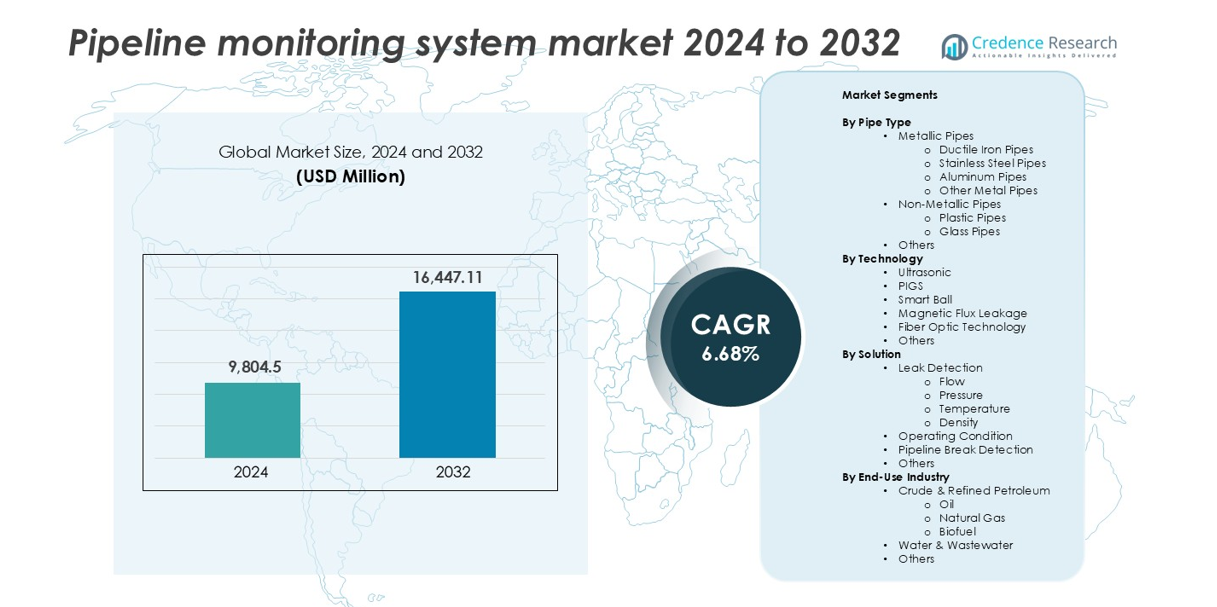- Introduction
1.1. Report Description
1.2. Purpose of the Report
1.3. USP & Key Offerings
1.4. Key Benefits for Stakeholders
1.5. Target Audience
1.6. Report Scope
1.7. Regional Scope
- Scope and Methodology
2.1. Objectives of the Study
2.2. Stakeholders
2.3. Data Sources
2.3.1. Primary Sources
2.3.2. Secondary Sources
2.4. Market Estimation
2.4.1. Bottom-Up Approach
2.4.2. Top-Down Approach
2.5. Forecasting Methodology
- Executive Summary
- Introduction
4.1. Overview
4.2. Key Industry Trends
- Global Pipeline Monitoring System Market
5.1. Market Overview
5.2. Market Performance
5.3. Impact of COVID-19
5.4. Market Forecast
- Market Breakup by Pipe Type
6.1. Metallic Pipes
6.1.1. Ductile Iron Pipes
6.1.2. Stainless Steel Pipes
6.1.3. Aluminum Pipes
6.1.4. Other Metal Pipes
6.2. Non-Metallic Pipes
6.2.1. Plastic Pipes
6.2.2. Glass Pipes
6.2.3. Others
- Market Breakup by Technology
7.1. Ultrasonic
7.1.1. Market Trends
7.1.2. Market Forecast
7.1.3. Revenue Share
7.1.4. Revenue Growth Opportunity
7.2. PIGS
7.2.1. Market Trends
7.2.2. Market Forecast
7.2.3. Revenue Share
7.2.4. Revenue Growth Opportunity
7.3. Smart Ball
7.3.1. Market Trends
7.3.2. Market Forecast
7.3.3. Revenue Share
7.3.4. Revenue Growth Opportunity
7.4. Magnetic Flux Leakage
7.4.1. Market Trends
7.4.2. Market Forecast
7.4.3. Revenue Share
7.4.4. Revenue Growth Opportunity
7.5. Fiber Optic Technology
7.5.1. Market Trends
7.5.2. Market Forecast
7.5.3. Revenue Share
7.5.4. Revenue Growth Opportunity
7.6. Others
7.6.1. Market Trends
7.6.2. Market Forecast
7.6.3. Revenue Share
7.6.4. Revenue Growth Opportunity
- Market Breakup by Solution
8.1. Leak Detection
8.1.1. Market Trends
8.1.2. Market Forecast
8.1.3. Revenue Share
8.1.4. Revenue Growth Opportunity
8.2. Flow
8.2.1. Market Trends
8.2.2. Market Forecast
8.2.3. Revenue Share
8.2.4. Revenue Growth Opportunity
8.3. Pressure
8.3.1. Market Trends
8.3.2. Market Forecast
8.3.3. Revenue Share
8.3.4. Revenue Growth Opportunity
8.4. Temperature
8.4.1. Market Trends
8.4.2. Market Forecast
8.4.3. Revenue Share
8.4.4. Revenue Growth Opportunity
8.5. Density
8.5.1. Market Trends
8.5.2. Market Forecast
8.5.3. Revenue Share
8.5.4. Revenue Growth Opportunity
8.6. Operating Condition
8.6.1. Market Trends
8.6.2. Market Forecast
8.6.3. Revenue Share
8.6.4. Revenue Growth Opportunity
8.7. Pipeline Break Detection
8.7.1. Market Trends
8.7.2. Market Forecast
8.7.3. Revenue Share
8.7.4. Revenue Growth Opportunity
8.8. Others
8.8.1. Market Trends
8.8.2. Market Forecast
8.8.3. Revenue Share
8.8.4. Revenue Growth Opportunity
- Market Breakup by End-Use Industry
9.1. Crude & Refined Petroleum
9.1.1. Market Trends
9.1.2. Market Forecast
9.1.3. Revenue Share
9.1.4. Revenue Growth Opportunity
9.2. Oil
9.2.1. Market Trends
9.2.2. Market Forecast
9.2.3. Revenue Share
9.2.4. Revenue Growth Opportunity
9.3. Natural Gas
9.3.1. Market Trends
9.3.2. Market Forecast
9.3.3. Revenue Share
9.3.4. Revenue Growth Opportunity
9.4. Biofuel
9.4.1. Market Trends
9.4.2. Market Forecast
9.4.3. Revenue Share
9.4.4. Revenue Growth Opportunity
9.5. Water & Wastewater
9.5.1. Market Trends
9.5.2. Market Forecast
9.5.3. Revenue Share
9.5.4. Revenue Growth Opportunity
9.6. Others
9.6.1. Market Trends
9.6.2. Market Forecast
9.6.3. Revenue Share
9.6.4. Revenue Growth Opportunity
- Market Breakup by Region
10.1. North America
10.1.1. United States
10.1.1.1. Market Trends
10.1.1.2. Market Forecast
10.1.2. Canada
10.1.2.1. Market Trends
10.1.2.2. Market Forecast
10.2. Asia-Pacific
10.2.1. China
10.2.2. Japan
10.2.3. India
10.2.4. South Korea
10.2.5. Australia
10.2.6. Indonesia
10.2.7. Others
10.3. Europe
10.3.1. Germany
10.3.2. France
10.3.3. United Kingdom
10.3.4. Italy
10.3.5. Spain
10.3.6. Russia
10.3.7. Others
10.4. Latin America
10.4.1. Brazil
10.4.2. Mexico
10.4.3. Others
10.5. Middle East and Africa
10.5.1. Market Trends
10.5.2. Market Breakup by Country
10.5.3. Market Forecast
- SWOT Analysis
11.1. Overview
11.2. Strengths
11.3. Weaknesses
11.4. Opportunities
11.5. Threats
- Value Chain Analysis
- Porter’s Five Forces Analysis
13.1. Overview
13.2. Bargaining Power of Buyers
13.3. Bargaining Power of Suppliers
13.4. Degree of Competition
13.5. Threat of New Entrants
13.6. Threat of Substitutes
- Price Analysis
- Competitive Landscape
15.1. Market Structure
15.2. Key Players
15.3. Profiles of Key Players
15.3.1. ABB Ltd. (Switzerland)
15.3.1.1. Company Overview
15.3.1.2. Product Portfolio
15.3.1.3. Financials
15.3.1.4. SWOT Analysis
15.3.2. Atmos International (United Kingdom)
15.3.2.1. Company Overview
15.3.2.2. Product Portfolio
15.3.2.3. Financials
15.3.2.4. SWOT Analysis
15.3.3. Baker Hughes Company (United States)
15.3.3.1. Company Overview
15.3.3.2. Product Portfolio
15.3.3.3. Financials
15.3.3.4. SWOT Analysis
15.3.4. ClampOn AS (Norway)
15.3.4.1. Company Overview
15.3.4.2. Product Portfolio
15.3.4.3. Financials
15.3.4.4. SWOT Analysis
15.3.5. Emerson Electric Co. (United States)
15.3.5.1. Company Overview
15.3.5.2. Product Portfolio
15.3.5.3. Financials
15.3.5.4. SWOT Analysis
15.3.6. Enbridge Inc. (Canada)
15.3.6.1. Company Overview
15.3.6.2. Product Portfolio
15.3.6.3. Financials
15.3.6.4. SWOT Analysis
15.3.7. General Electric Company (United States)
15.3.7.1. Company Overview
15.3.7.2. Product Portfolio
15.3.7.3. Financials
15.3.7.4. SWOT Analysis
15.3.8. Honeywell International Inc. (United States)
15.3.8.1. Company Overview
15.3.8.2. Product Portfolio
15.3.8.3. Financials
15.3.8.4. SWOT Analysis
15.3.9. Perma-Pipe International Holdings, Inc. (United States)
15.3.9.1. Company Overview
15.3.9.2. Product Portfolio
15.3.9.3. Financials
15.3.9.4. SWOT Analysis
15.3.10. PSI AG (Germany)
15.3.10.1. Company Overview
15.3.10.2. Product Portfolio
15.3.10.3. Financials
15.3.10.4. SWOT Analysis
15.3.11. Pure Technologies Ltd. (Canada)
15.3.11.1. Company Overview
15.3.11.2. Product Portfolio
15.3.11.3. Financials
15.3.11.4. SWOT Analysis
15.3.12. Rohrback Cosasco Systems (United States)
15.3.12.1. Company Overview
15.3.12.2. Product Portfolio
15.3.12.3. Financials
15.3.12.4. SWOT Analysis
15.3.13. Schneider Electric SE (France)
15.3.13.1. Company Overview
15.3.13.2. Product Portfolio
15.3.13.3. Financials
15.3.13.4. SWOT Analysis
15.3.14. Senstar Corporation (Canada)
15.3.14.1. Company Overview
15.3.14.2. Product Portfolio
15.3.14.3. Financials
15.3.14.4. SWOT Analysis
15.3.15. Siemens AG (Germany)
15.3.15.1. Company Overview
15.3.15.2. Product Portfolio
15.3.15.3. Financials
15.3.15.4. SWOT Analysis
15.3.16. TC Energy (formerly TransCanada Corporation) (Canada)
15.3.16.1. Company Overview
15.3.16.2. Product Portfolio
15.3.16.3. Financials
15.3.16.4. SWOT Analysis
15.3.17. Yokogawa Electric Corporation (Japan)
15.3.17.1. Company Overview
15.3.17.2. Product Portfolio
15.3.17.3. Financials
15.3.17.4. SWOT Analysis
- Research Methodology




